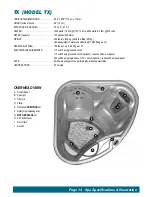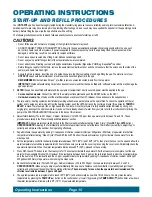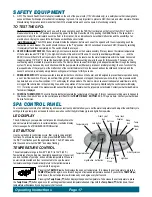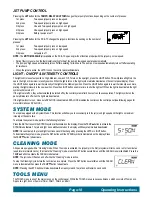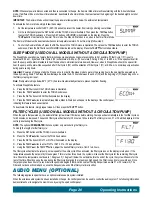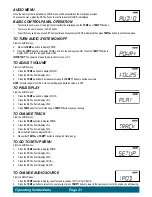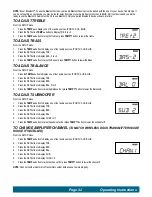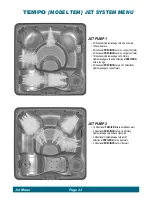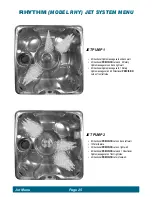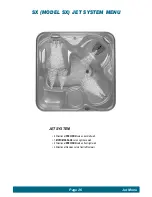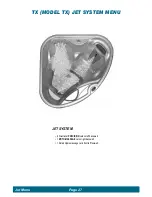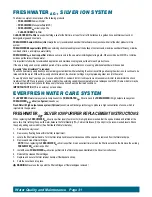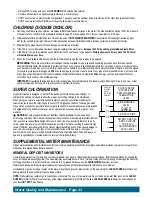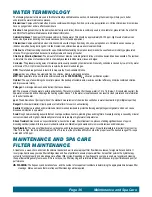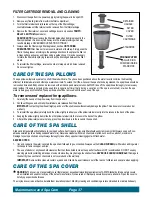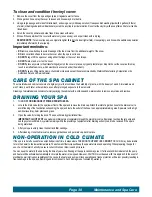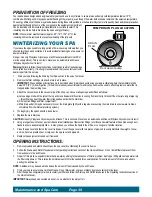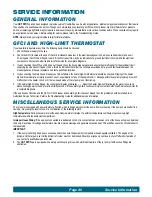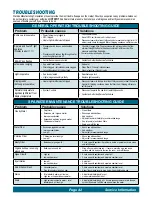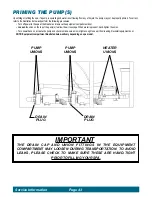
WATER QUALITY ANd MAINTENANCE
It’s important to have clean water. Water maintenance is one of the least understood, yet most important areas of spa ownership. Your dealer can
guide you through the process of achieving and maintaining perfect water in your spa, given your local conditions. your program will depend on
your water’s mineral content, how often you use your spa, and how many people use it.
Watkins recommends that you either use an entirely chlorine-based system, or an alternative system which uses silver ions (the
FReSHWateR
ag+
silver ion purifier).
Hot SpRING
FReSHWateR
products, which Watkins recommends, are available from authorized
Hot Spot
dealers.
GENERAl INFORMATION
THE THrEE FundAMEnTAl ArEAS oF WATEr MAInTEnAnCE:
• Water Filtration
• Water sanitation
• Chemical Balance/pH Control
Water sanitation is the responsibility of the spa owner, achieved through the regular and periodic (daily, if necessary) addition of an approved
sanitizer. The sanitizer will chemically control the bacteria and viruses present in the fill water or introduced during use of the spa. Bacteria and
viruses can grow quickly in undersanitized spa water.
The water’s chemical balance and pH control are also the responsibility of the spa owner. You’ll have to add chemicals to maintain proper levels of
Total Alkalinity (TA), calcium Hardness (cH) and pH. Proper water balance and pH control will minimize scale buildup, extend the life of the spa,
and allow the sanitizer to work at top efficiency.
METHOdS FOR TESTING THE SPA WATER
Accurate water testing and analysis is an important part of effectively managing your spa water. you must have the ability to test for:
• Total Alkalinity (TA)
• Calcium Hardness (CH)
• pH
• Sanitizer
Two types of testing methods are recognized and recommended by Watkins:
the Reagent test Kit
is a method which provides a high level of accuracy. The reagents come in either liquid or tablet form.
FReSHWateR test Strips
are a convenient testing method used by many spa owners. Keep in mind that test strips are susceptible to heat and
moisture contamination, which will result in inaccurate readings.
ImpoRtaNt:
Always read and carefully follow the directions included with the Test Kit or Test Strips to ensure the accuracy of the test results.
bASIC CHEMICAl SAFETY
When using chemicals, read the labels carefully and follow directions precisely. Though chemicals protect you and your spa when used correctly,
they can be hazardous in concentrated form. Always observe the following guidelines:
• Allow only a responsible person to handle spa chemicals. Keep them out of the reach of children.
• Accurately measure the exact quantities specified, never more. Do not overdose your spa.
• Handle all containers with care. Store in a cool, dry, well ventilated place.
• Always keep chemical containers closed when not in use. Replace caps on their proper containers.
• Follow the emergency advice on the product label in case of accidental contact, or if the chemical is swallowed. Call a doctor or the local
Poison control center. If a doctor is needed, take the product container along so that the substance can be identified.
• Don’t inhale fumes or allow chemicals to come in contact with your eyes, nose, or mouth. Wash your hands immediately after use.
• Don’t let chemicals get on surrounding surfaces or landscaping.
• Don’t use a vacuum cleaner to clean up chemical spills.
• Never smoke around chemicals. Some fumes can be highly flammable.
• Don’t store any chemicals in the spa equipment compartment.
HoW To Add CHEMICAlS To THE WATEr
ImpoRtaNt:
All spa water chemicals including MPs (shock), chlorine, granulated pH increaser or decreaser, granulated total alkalinity increaser,
calcium hardness increaser, liquid stain and scale inhibitor, and liquid defoamer must always be added directly into the filter compartment while the
jet pump is running in high speed mode, and it must run for a minimum of ten minutes.
page 28 Water Quality and Maintenance
Summary of Contents for 2014 REL
Page 1: ...2014 Owner s Manual...
Page 47: ......

